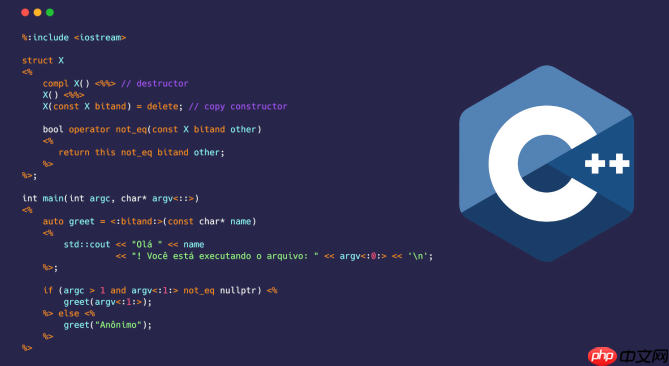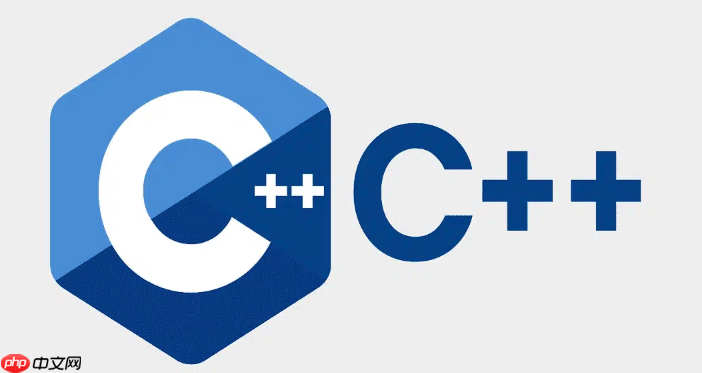推荐使用aes加密算法保护文件存储,因为它能有效防止未经授权访问,确保数据安全。具体实现需注意:1.选择gc++m模式,因其提供加密和认证功能,可检测篡改;2.使用openssl等第三方库在c++中实现;3.通过kdf、hsm或kms等方式安全管理密钥;4.妥善处理错误,如检查返回值和记录日志;5.解密时需使用相同的密钥、iv和模式;6.通过硬件加速、多线程等方式优化性能;7.定期进行代码审查、渗透测试等安全审计措施以确保整体方案安全性。

直接使用AES加密算法来保护你的文件存储,这绝对是一个靠谱的选择。它能有效防止未经授权的访问,确保你的数据安全。

AES加密算法文件保护方案

AES(Advanced Encryption Standard)是一种对称密钥加密算法,简单来说,加密和解密使用同一个密钥。在C++中实现AES加密文件存储,需要考虑密钥管理、加密模式选择、以及错误处理等多个方面。
立即学习“C++免费学习笔记(深入)”;
AES算法本身只定义了如何对一个固定大小的数据块(通常是128位)进行加密。要加密任意大小的文件,我们需要选择一种合适的加密模式。常见的模式包括:

推荐使用GCM模式,因为它既提供了加密,又提供了数据完整性校验,能有效防止中间人攻击。
C++本身没有内置的AES加密库,需要使用第三方库。比较流行的选择包括:
这里以OpenSSL为例,展示一个简单的AES-256-GCM加密文件的代码片段:
#include <iostream>
#include <fstream>
#include <openssl/evp.h>
#include <openssl/rand.h>
int encrypt_file(const std::string& input_file, const std::string& output_file, const std::string& password) {
// 1. 生成随机盐值(Salt)和初始化向量(IV)
unsigned char salt[16];
unsigned char iv[16];
if (RAND_bytes(salt, sizeof(salt)) != 1 || RAND_bytes(iv, sizeof(iv)) != 1) {
std::cerr << "Error generating random bytes" << std::endl;
return -1;
}
// 2. 使用密码和盐值派生密钥和IV
unsigned char key[32]; // AES-256 requires 32-byte key
if (EVP_BytesToKey(EVP_aes_256_gcm(), EVP_sha256(), salt, (unsigned char*)password.c_str(), password.length(), 1, key, iv) == 0) {
std::cerr << "Error deriving key" << std::endl;
return -1;
}
// 3. 初始化加密上下文
EVP_CIPHER_CTX *ctx = EVP_CIPHER_CTX_new();
if (!ctx) {
std::cerr << "Error creating cipher context" << std::endl;
return -1;
}
if (EVP_EncryptInit_ex(ctx, EVP_aes_256_gcm(), NULL, NULL, NULL) != 1) {
std::cerr << "Error initializing cipher" << std::endl;
EVP_CIPHER_CTX_free(ctx);
return -1;
}
if (EVP_CIPHER_CTX_ctrl(ctx, EVP_CTRL_GCM_SET_IVLEN, sizeof(iv), NULL) != 1) {
std::cerr << "Error setting IV length" << std::endl;
EVP_CIPHER_CTX_free(ctx);
return -1;
}
if (EVP_EncryptInit_ex(ctx, NULL, NULL, key, iv) != 1) {
std::cerr << "Error setting key and IV" << std::endl;
EVP_CIPHER_CTX_free(ctx);
return -1;
}
// 4. 读取输入文件,加密数据,写入输出文件
std::ifstream infile(input_file, std::ios::binary);
std::ofstream outfile(output_file, std::ios::binary);
if (!infile.is_open() || !outfile.is_open()) {
std::cerr << "Error opening files" << std::endl;
EVP_CIPHER_CTX_free(ctx);
return -1;
}
// 先写入盐值和IV
outfile.write(reinterpret_cast<char*>(salt), sizeof(salt));
outfile.write(reinterpret_cast<char*>(iv), sizeof(iv));
const int BUFFER_SIZE = 4096;
unsigned char inbuf[BUFFER_SIZE];
unsigned char outbuf[BUFFER_SIZE + EVP_MAX_BLOCK_LENGTH]; // 确保输出缓冲区足够大
int bytes_read, bytes_written;
while (infile.read(reinterpret_cast<char*>(inbuf), BUFFER_SIZE) || infile.gcount() > 0) {
bytes_read = infile.gcount();
if (EVP_EncryptUpdate(ctx, outbuf, &bytes_written, inbuf, bytes_read) != 1) {
std::cerr << "Error encrypting data" << std::endl;
EVP_CIPHER_CTX_free(ctx);
return -1;
}
outfile.write(reinterpret_cast<char*>(outbuf), bytes_written);
}
// 5. 完成加密
if (EVP_EncryptFinal_ex(ctx, outbuf, &bytes_written) != 1) {
std::cerr << "Error finalizing encryption" << std::endl;
EVP_CIPHER_CTX_free(ctx);
return -1;
}
outfile.write(reinterpret_cast<char*>(outbuf), bytes_written);
// 6. 获取GCM认证标签
unsigned char tag[16];
if (EVP_CIPHER_CTX_ctrl(ctx, EVP_CTRL_GCM_GET_TAG, 16, tag) != 1) {
std::cerr << "Error getting GCM tag" << std::endl;
EVP_CIPHER_CTX_free(ctx);
return -1;
}
outfile.write(reinterpret_cast<char*>(tag), sizeof(tag));
// 7. 清理
EVP_CIPHER_CTX_free(ctx);
infile.close();
outfile.close();
std::cout << "File encrypted successfully." << std::endl;
return 0;
}
int main() {
std::string input_file = "input.txt";
std::string output_file = "output.enc";
std::string password = "my_secret_password";
if (encrypt_file(input_file, output_file, password) != 0) {
std::cerr << "Encryption failed." << std::endl;
return 1;
}
return 0;
}这段代码演示了如何使用OpenSSL进行AES-256-GCM加密。 注意,代码中使用了固定的密码,在实际应用中应该使用更安全的方式来管理密钥。
密钥的安全至关重要。直接在代码中硬编码密钥是极其危险的。一些更安全的密钥管理方案包括:
选择哪种方案取决于你的安全需求和预算。对于简单的应用,使用KDF可能就足够了。对于高安全要求的应用,可能需要使用HSM或KMS。
加密过程中可能会出现各种错误,例如文件打开失败、内存分配失败、加密算法初始化失败等。应该妥善处理这些错误,避免程序崩溃或数据损坏。
解密过程与加密过程类似,但需要使用相同的密钥、IV和加密模式。以下是一个简单的解密文件的代码片段:
#include <iostream>
#include <fstream>
#include <openssl/evp.h>
#include <openssl/rand.h>
int decrypt_file(const std::string& input_file, const std::string& output_file, const std::string& password) {
// 1. 读取盐值和IV
unsigned char salt[16];
unsigned char iv[16];
std::ifstream infile(input_file, std::ios::binary);
if (!infile.is_open()) {
std::cerr << "Error opening input file" << std::endl;
return -1;
}
infile.read(reinterpret_cast<char*>(salt), sizeof(salt));
infile.read(reinterpret_cast<char*>(iv), sizeof(iv));
// 2. 使用密码和盐值派生密钥
unsigned char key[32];
if (EVP_BytesToKey(EVP_aes_256_gcm(), EVP_sha256(), salt, (unsigned char*)password.c_str(), password.length(), 1, key, iv) == 0) {
std::cerr << "Error deriving key" << std::endl;
return -1;
}
// 3. 初始化解密上下文
EVP_CIPHER_CTX *ctx = EVP_CIPHER_CTX_new();
if (!ctx) {
std::cerr << "Error creating cipher context" << std::endl;
return -1;
}
if (EVP_DecryptInit_ex(ctx, EVP_aes_256_gcm(), NULL, NULL, NULL) != 1) {
std::cerr << "Error initializing cipher" << std::endl;
EVP_CIPHER_CTX_free(ctx);
return -1;
}
if (EVP_CIPHER_CTX_ctrl(ctx, EVP_CTRL_GCM_SET_IVLEN, sizeof(iv), NULL) != 1) {
std::cerr << "Error setting IV length" << std::endl;
EVP_CIPHER_CTX_free(ctx);
return -1;
}
if (EVP_DecryptInit_ex(ctx, NULL, NULL, key, iv) != 1) {
std::cerr << "Error setting key and IV" << std::endl;
EVP_CIPHER_CTX_free(ctx);
return -1;
}
// 4. 读取输入文件,解密数据,写入输出文件
std::ofstream outfile(output_file, std::ios::binary);
if (!outfile.is_open()) {
std::cerr << "Error opening output file" << std::endl;
EVP_CIPHER_CTX_free(ctx);
return -1;
}
const int BUFFER_SIZE = 4096;
unsigned char inbuf[BUFFER_SIZE];
unsigned char outbuf[BUFFER_SIZE + EVP_MAX_BLOCK_LENGTH];
int bytes_read, bytes_written;
// 跳过盐值和IV
infile.seekg(sizeof(salt) + sizeof(iv));
while (infile.read(reinterpret_cast<char*>(inbuf), BUFFER_SIZE) || infile.gcount() > 0) {
bytes_read = infile.gcount();
if (EVP_DecryptUpdate(ctx, outbuf, &bytes_written, inbuf, bytes_read) != 1) {
std::cerr << "Error decrypting data" << std::endl;
EVP_CIPHER_CTX_free(ctx);
return -1;
}
outfile.write(reinterpret_cast<char*>(outbuf), bytes_written);
}
// 5. 验证GCM认证标签
unsigned char tag[16];
infile.read(reinterpret_cast<char*>(tag), sizeof(tag));
if (EVP_CIPHER_CTX_ctrl(ctx, EVP_CTRL_GCM_SET_TAG, 16, tag) != 1) {
std::cerr << "Error setting GCM tag" << std::endl;
EVP_CIPHER_CTX_free(ctx);
return -1;
}
// 6. 完成解密
if (EVP_DecryptFinal_ex(ctx, outbuf, &bytes_written) != 1) {
std::cerr << "Error finalizing decryption" << std::endl;
EVP_CIPHER_CTX_free(ctx);
return -1;
}
outfile.write(reinterpret_cast<char*>(outbuf), bytes_written);
// 7. 清理
EVP_CIPHER_CTX_free(ctx);
infile.close();
outfile.close();
std::cout << "File decrypted successfully." << std::endl;
return 0;
}
int main() {
std::string input_file = "output.enc"; // 加密后的文件
std::string output_file = "output.txt"; // 解密后的文件
std::string password = "my_secret_password";
if (decrypt_file(input_file, output_file, password) != 0) {
std::cerr << "Decryption failed." << std::endl;
return 1;
}
return 0;
}这段代码演示了如何使用OpenSSL进行AES-256-GCM解密。 同样需要注意密钥管理和错误处理。
对于需要处理大量数据的应用,加密解密速度可能成为瓶颈。一些性能优化技巧包括:
即使使用了强大的加密算法,也需要进行安全审计,确保加密方案的安全性。
记住,安全是一个持续的过程,需要不断地进行评估和改进。
以上就是怎样用C++实现加密文件存储 AES加密算法文件保护方案的详细内容,更多请关注php中文网其它相关文章!

每个人都需要一台速度更快、更稳定的 PC。随着时间的推移,垃圾文件、旧注册表数据和不必要的后台进程会占用资源并降低性能。幸运的是,许多工具可以让 Windows 保持平稳运行。

Copyright 2014-2025 https://www.php.cn/ All Rights Reserved | php.cn | 湘ICP备2023035733号